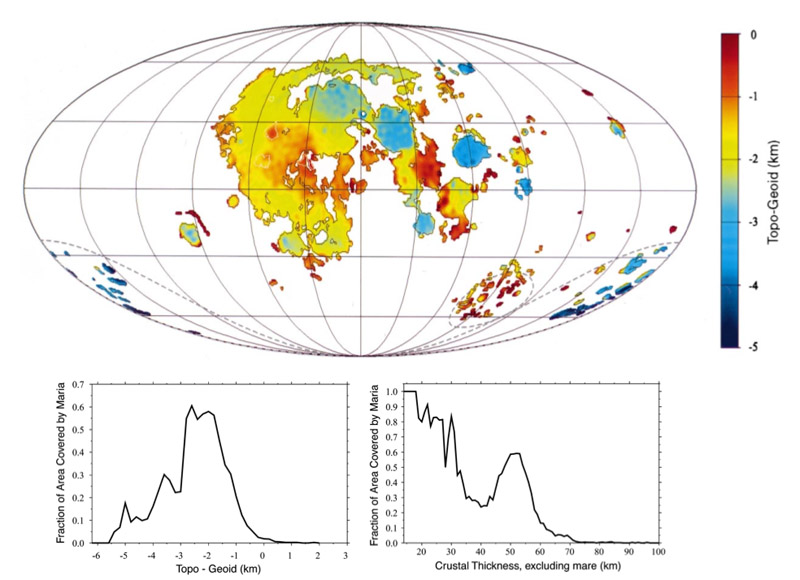August 17, 2009
Why Are Maria Where They Are?

images from Wieczorek, Zuber & Phillips (2001)
Most maria occur inside impact basins that are lower than the surrounding terrain. In 1971 when Bill Hartmann and I did a global survey of basins we discovered that there were about as many on the farside as on the familiar nearside, but as Luna 3 showed there are almost no maria on the farside. Impact basins on the farside must have dug deep holes too so the lack of maria there was a surprise and a mystery. But another Apollo era discovery offered a solution. Apparently the farside crust was roughly 10 km thicker than the nearside. This led to the idea that maria occurrence was driven by hydrostatic pressure - anyplace low enough should be flooded by mare lavas. This is generally true for the nearside. In 2001 Mark Wieczorek and his colleagues used these graphs to test if maria do occur where topography is low and/or crust is thin. The map shows the elevation (compared to the lunar geoid) of mare surfaces. It is fascinating to see the variation in mare levels - Crisium and Serenitatis are a kilometer or so lower than most nearside maria, and eastern Tranquilitatis is perhaps a kilometer higher than the western half. But the real evidence against hydrostatic pressure accounting for mare eruptions is the graph on the left. It shows how much of the Moon's topography at different elevations is covered with maria. Almost no land higher than 0 km has lava flows, and most mare lavas cover terrains that are 1-3 km lower than the geoid. But virtually none of the deepest areas of the Moon are covered by lavas. The deepest bits are inside the South Pole-Aitken Basin (SPA) on the farside. The second graph shows that maria are pervasive where the crust is thinnest, but not for SPA which has a crust 40 km thick. Interestingly the large excess of maria at 50 km crust thickness is Oceanus Procellarum. These graphs show that low elevation and crustal thickness do have some influence on the occurrence of maria, but SPA and Procellarum seem to be anomalies. A better theory tomorrow.
Chuck Wood
Technical Details
A geoid is an equipotential surface where the force of gravity is perpendicular to the surface; if a planet were made of liquid its surface would be a geoid.
Related Links
Many of Mark's papers on lunar geophysics are available - click the reprint selection.
Yesterday's LPOD: Big Bounce
Tomorrow's LPOD: Buoyant And Superhot
COMMENTS?
Register, Log in, and join in the comments.



